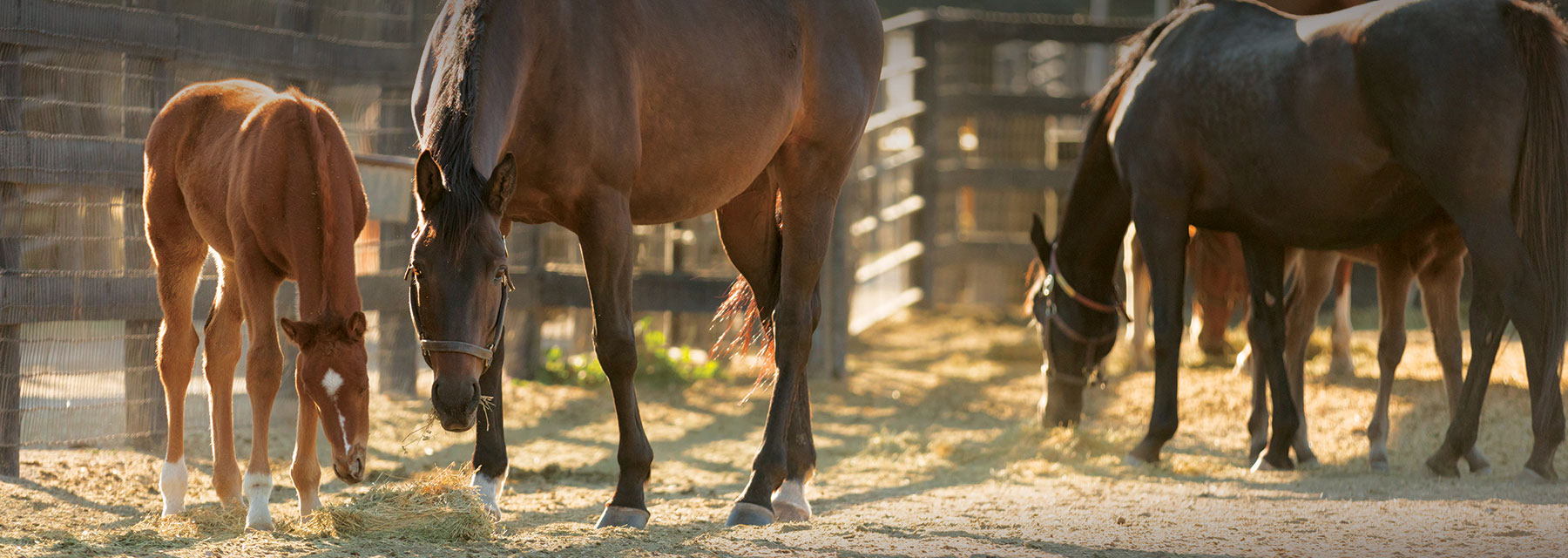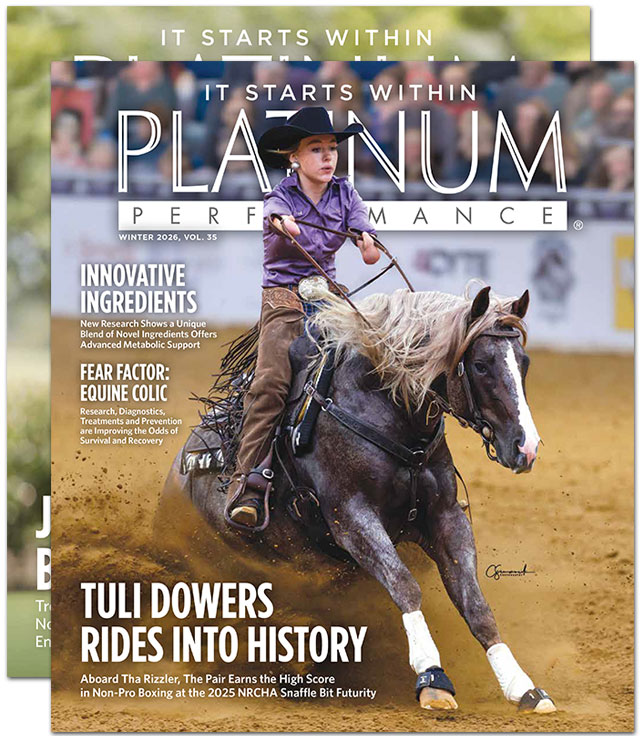Focus on the Recipient Mare to Maximize a Foal’s Genetic Potential
Embryo transfer, utilized since the 1970s, is an equine reproduction technique where the donor mare is inseminated (naturally or artificially), and, as opposed to carrying a foal to term, the 6- to 8-day-old embryo is flushed from the uterus and implanted into a recipient mare that carries, delivers and often nurses the foal until weaning. The process offers many benefits. It allows the donor mares, often with desirable genetics, to continue performance careers while still producing foals with their bloodlines. It can allow the production of more than one foal from a mare per season. It can be used if a donor mare has reproductive issues and is unable to carry a pregnancy to term. Embryo transfer also allows older mares to continue reproducing as female equines can produce eggs into their 20s but may be unable to carry a foal at that age.
Essentially a surrogate, the recip, or recipient mare, carries a valuable investment, and, although not genetically related, still importantly exerts great influence as the embryo progresses from fetus to foal. The health of the offspring relies significantly on the health of the broodmare, and nutrition is a critical factor. What she consumes directly influences the growth and development of the fetus — in utero and after foaling. Providing optimal nutrition for the recipient broodmare can be impactful, yet should not be complicated. Maintaining a healthy body condition throughout gestation and lactation based on a forage diet, with supplements filling nutrient gaps, will set mare and foal up and for success.
Proper care and management of the recipient mare not only affects the developing foal but also that of the mare. Healthy mares kept in good body condition have improved conception rates and shorter rebreeding cycles. It is a very worthwhile undertaking to keep the broodmare healthy and happy throughout all the stages of reproduction — maintenance, gestation, lactation, rebreeding — and everything in between.
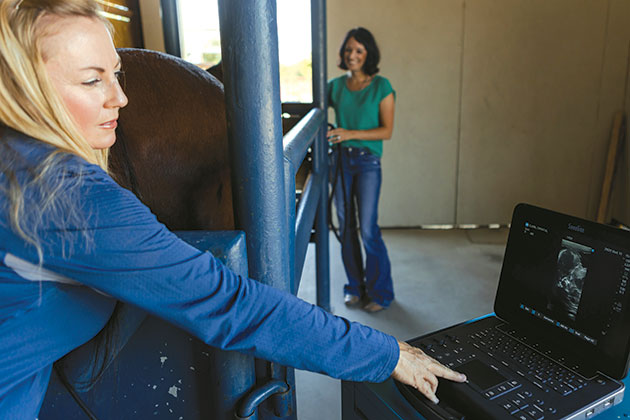
What is a Recipient Mare?
A recipient mare is the surrogate that an embryo is transferred into via the embryo transfer reproductive technique. Commonly referred to as a “recip,” this type of broodmare is ideally under 15 years old, in good physical condition and is easy to handle.
ICSI in Horses
In recent years, intracytoplasmic spermatazoal injection (ICSI), a technique first performed in the late 1990s, has become much more accessible. In this technique, multiple unfertilized eggs (oocytes) are harvested from a mare’s ovaries, and under microscopic guidance a single sperm is injected into each viable oocyte. The resulting embryos are incubated until they are mature enough to transfer, then the embryos are transferred into recipient mares or frozen for later use.
Body Conditioning
Basic and straightforward is usually the best way to feed every horse, especially gestating mares. One of the easiest strategies is to feed to maintain a healthy body condition and make adjustments as needed to keep her in good weight. The body condition score (BCS) is widely accepted as an important health monitoring system for any horse. It is a useful tool to gauge weight and condition of broodmares. It can make it easier to assess and keep track of her body condition changes throughout gestation and lactation, and help determine when feeding adjustments are necessary. The commonly used Henneke BCS system, developed over 40 years ago, is based on a 1 to 9 scale, with 1 being emaciated and 9 being obese. Most experts recommend maintaining broodmares in a body condition between 5 and 6 (moderate to fleshy), staying toward the higher end when entering breeding season and — more importantly — into late gestation. This ensures mares have body stores available to support rapid fetal development, foaling and lactation.
Body condition can affect reproductive efficiency. A body condition score of 5 or above is recommended for optimal reproductive efficiency — mares cycle earlier, take fewer breedings to conceive and have a higher conception rate than thin mares. Malnourished or very thin mares are also more likely to abort an early embryo. Nutritionally deprived broodmares tend to have longer pregnancies due to an inadequate attachment of the placenta within the uterus. This can increase the time the fetus requires to get essential nutrients in order to grow.
Conversely, obesity can also negatively influence fetal development by impacting placental function and affecting nutrient transfer to the fetus in utero. Compared to thin mares or mares kept at an ideal body condition, obese mares may have more difficulties foaling and may produce less milk. Obese broodmares can be predisposed to metabolic issues with reduced glucose tolerance and insulin sensitivity. Keeping the broodmare in good weight before, during and after gestation will make sure that mare and foal are set up for continued good health.
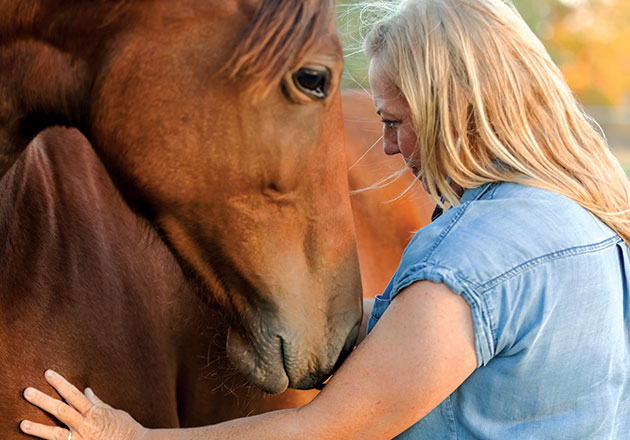
Dr. Melissa Patten, of River Grove Veterinary Services, specializes in equine reproduction. She helps clients with collecting, breeding and foaling.
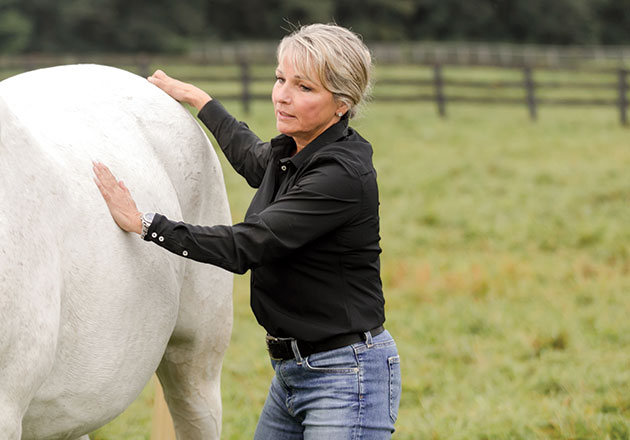
The health of the offspring relies significantly on the health of the broodmare, and nutrition is a critical factor. What she consumes directly influences the growth and development of the fetus — in utero and after foaling.
Maintenance for Barren Recip Mares
The maintenance of barren mares, maiden mares and mares that are not pregnant or just coming off of a pregnancy can sometimes be an afterthought. If you are considering using a mare as an embryo recipient, a better strategy is to plan ahead. If the mare has been living out on pasture and will be pulled into the barn at the beginning of breeding season, she may or may not be in peak health and body condition. Mares that have lost significant weight may have even stopped cycling. Take time before breeding to feed them to an ideal body condition — at or above BCS 5 — so she enters breeding season in good health. Focus on body condition and work to help her achieve that ideal a few months before in advance so there is time to adjust body condition at a deliberate and healthy pace. This is also a good time to have your veterinarian take a blood sample and check that everything is normal and within healthy ranges. Supplement potential recip mares with a comprehensive wellness formula, which includes omega-3 fatty acids, vitamins, minerals, amino acids and antioxidants to ensure these essential nutrients are available for a successful embryo transfer. Start her on a pre- and probiotic to promote a healthy hindgut and support immune health. Have forage analyses done on your pasture and hay to assess if any nutrients are low or depleted that need to be specifically supplemented during gestation.
The Recip Mare Diet
A common mistake when feeding a mare in foal is to overfeed grain or concentrate (calories) and underfeed vitamins and minerals. The following no-fuss diet will simplify feeding your broodmare.
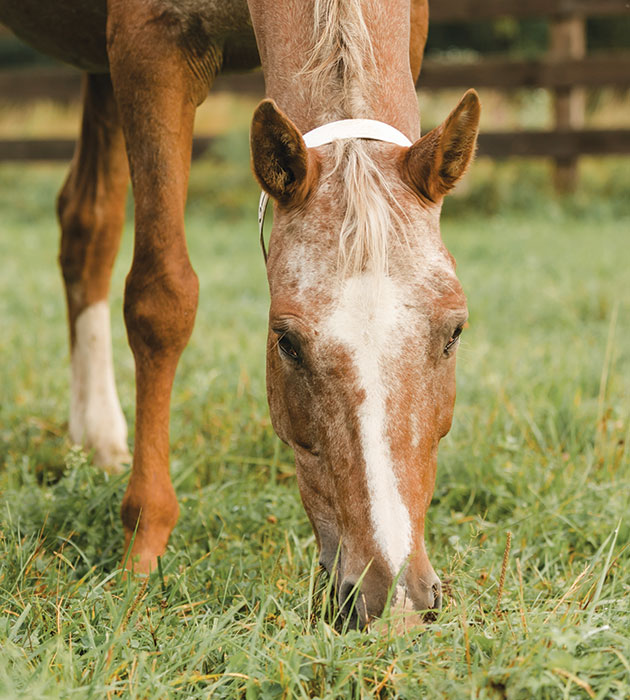
- Pasture: If you have it, use it. Fresh pasture provides high fiber and several vitamins in their natural, most bioavailable form, such as beta carotene and vitamin E, and offers an ideal ratio of omega-3 fatty acids.
- Hay: Use a good quality grass hay that is less than a year old and provide it free choice.
- Alfalfa: An excellent source of protein and calcium, alfalfa is great to blend with a quality grass hay to provide additional nutrition to the mare, developing fetus and foal.
- Vitamins and minerals: Use a comprehensive vitamin and mineral wellness supplement from the start. Broodmares can remain on a supplement all year, but this is especially important during gestation and lactation. Pregnant mares without access to pasture will likely need to be supplemented with vitamins A and E. Selenium is another very important mineral for a broodmare. It has a narrow safety margin, so it may be worth investing in a hay analysis to know if supplementation is needed. Remember to add all sources together — pasture, hay, concentrates, supplements, etc. — to decide if selenium supplements are needed.
- Omega-3 fatty acids: Important for the health of every mare but especially for those without access to pasture. Provide a source of omega-3 fats throughout gestation and lactation.
- Salt: Plain, white and always available.
- Concentrates: If extra calories are needed to maintain body condition, such as during lactation, look for a fortified feed designed for broodmares or mares and foals. Reputable feed producers consider the mare’s needs in addition to those of the developing foal and will include quality sources of protein and balanced levels of vitamins and minerals.
Feeding the Recipient Broodmare
Throughout the pregnancy, nutrition remains important. First, the recipient mare needs to maintain her own body condition. Then, there are the nutrients above the mare’s own requirements that are needed to synthesize fetal tissue and support fetal growth. The creation of the placenta, the augmenting of the uterus, and enlarging and prepping the mammary glands for lactation will increase nutrient requirements. Lastly, it is a huge nutritional toll to produce milk for the foal. Providing the mare with a forage-based, balanced diet is a simple, preventative way to set up both her and her foal for health and wellness.
Like all horses, broodmares thrive on forage — and many do fine on high-quality forage alone from start to finish. Good quality pasture and hay should make up the majority of the diet throughout all stages of pregnancy and into lactation. Broodmares should be fed as much forage as needed — free choice if possible — to maintain a healthy body condition, supplemented with concentrated feeds if additional calories are needed. It is recommended to minimize concentrated feeds that often contain high starch and sugar levels, which are associated with several equine health issues, including metabolic concerns, digestive disturbances and colic. The higher the quality of forage fed to the broodmare, the lower the amount of concentrate will be necessary to meet nutrient needs. Feed the smallest amount of concentrate needed to maintain the mare within the 5 to 6 BCS range. If she can maintain her weight on forage only, it is not necessary to add a concentrate. A daily comprehensive omega-3 fatty acid, vitamin and trace mineral supplement is recommended to complement the forage and fill in any lacking nutrients. Plain, white salt and fresh water should always be available.
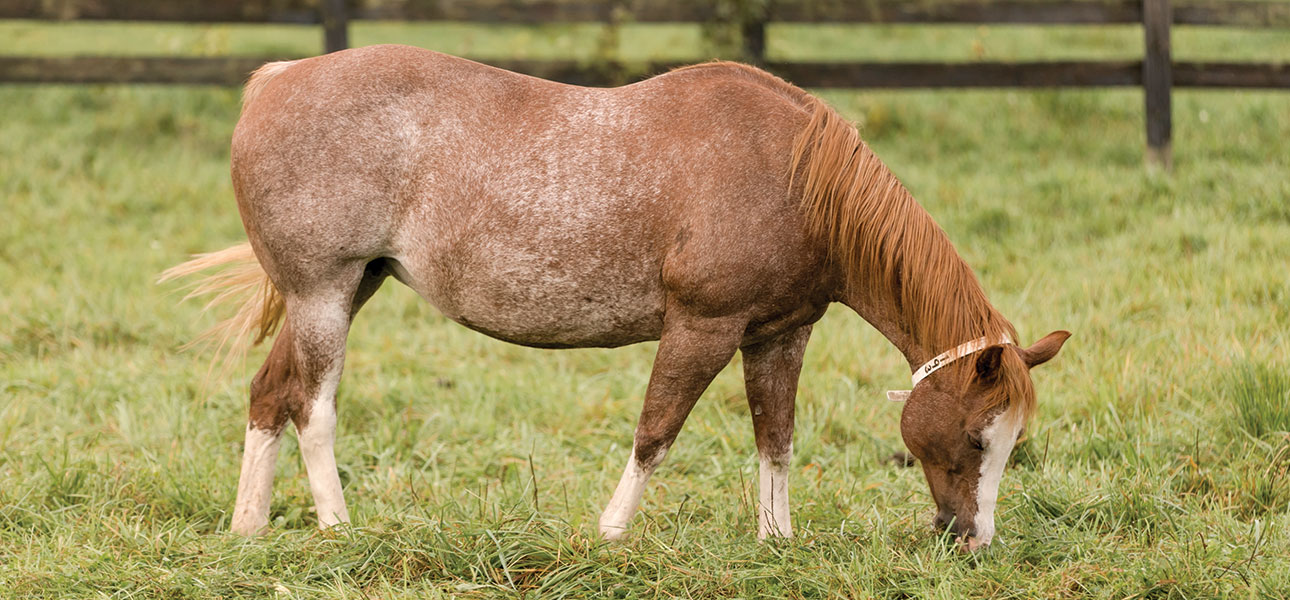
What is a concentrate?
A concentrate is a type of specialized feed that provides a condensed, or concentrated, source of calories. Examples include cereal grains, like corn, oats and barley, as well as commercial mixes and fortified sweet feeds and pellets. Concentrates are typically added to a horse’s diet to add energy or calories to maintain or gain weight or support exercise intensity. When needed, concentrates should be used to complement forage. For broodmares, concentrates are added when the forage portion of the diet does not provide enough calories to maintain an ideal body condition. They are often used in late gestation and/ or early lactation to help the mare maintain a healthy weight range.
Gestation: Embryo Transfer to Month Five
Normal equine gestation averages about 11 months, ranging from 320 to 360 days. During the first months of pregnancy, nutrient needs do not change significantly above the mare’s maintenance requirements. However, it is important that the maintenance nutritional needs are actually being met to support hormonal balance and early fetal growth. For the first half of gestation, development of the fetus is slow — approximately 0.2 pounds per day — but it is still a critical growth period. For early to mid-gestation, good quality forage will likely meet energy and protein requirements and concentrates may not be necessary unless weight gain is needed. These nutrient requirements begin to increase around month five and continue to rise in the final six months and into lactation. In the early gestational months, typical feeding recommendations are similar to a maintenance life-stage level of approximately 1 megacalorie per pound of feed. For an average-size 1,100-pound mare, this is approximately 15-22 pounds of forage depending on the roughage quality and the individual horse’s metabolism. A balanced forage diet that provides high-quality protein and amino acids with a comprehensive vitamin and mineral supplement and a source of omega-3 fatty acids is an excellent way to support broodmare and early foal development.
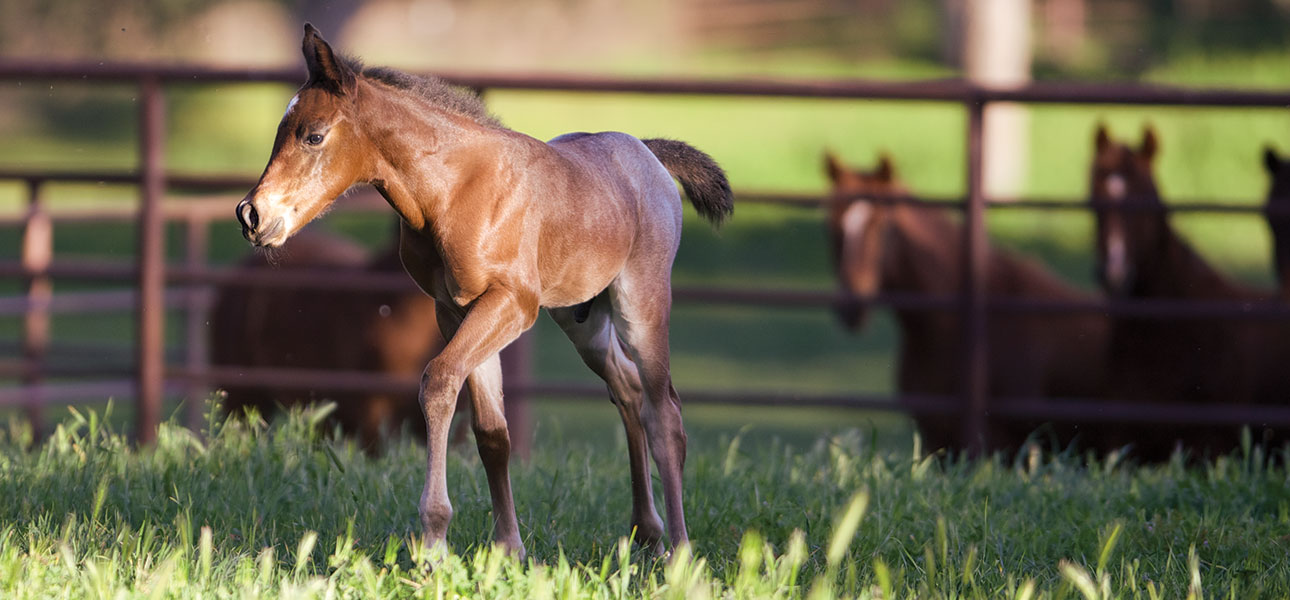
Gestation: Month Six to Foaling
The second half of gestation requires a greater focus on nutrition as the mare needs to sustain her body condition while nourishing a more rapidly growing foal in utero. Continue to feed to the ideal body condition — fleshy not fat. At this point, the mare will likely need about 10-20% more calories and higher levels of protein and amino acids to support fetal growth as well as moderate increases in some vitamins and minerals. If the mare has been maintained up to this point on a forage-only diet and continues to hold her weight well, consider adding a comprehensive omega-3 fatty acid, vitamin and mineral supplement or a balancer pellet to meet the increasing nutrient demands. If the mare requires more calories than what forage provides, add a concentrated feed or flaxseed oil. If the mare is consuming more than 4-5 pounds of a fortified concentrate daily, a balancer pellet is not necessary as micronutrient needs will likely be met by the concentrate.
In the last 90 days before birth, the foal will double in size with about 65% of total fetal growth happening in the final trimester. During this phase, the mare will gain about a pound a day. Total gestational weight gain is typically around 12-16% of the mare’s pre-pregnancy body weight. As she approaches the end of gestation, several nutrients are needed in moderately higher levels than the basic maintenance requirements. Calories and energy will be needed to maintain her weight and support the growth of the fetus. Protein and amino acids will support fetal tissue development and prepare reserves for the significant drain of lactation. Calcium, phosphorus and magnesium are required in balance and need to be available from the diet to support bone and soft tissue development. Copper, another critical development mineral, is needed for healthy fetal skeletal and cartilage tissue. Mare’s milk is basically devoid of copper, so the mare provides it to the fetus in utero to support growth. The antioxidant vitamin E increases passive transfer of antibodies from mare to foal, a significant immune benefit. During this second half of gestation, broodmares may eat slightly more hay given the choice — nearly 2-2.5% their body weight — that will help cover the spread of the increased nutrient requirements. A good general guideline to follow is to provide a good quality 40/60 alfalfa/grass hay mix or blend free choice with 1-2 pounds of a 30% protein balancer. As with earlier in the pregnancy, the higher the quality of forage, the lower the amount of concentrate is needed.
As the mare approaches the end of gestation and is close to foaling, she may back off feed (hay included) as her body literally runs out of room as the fetus increases in size. Providing enough nourishment to the mare during this period is essential as underfed mares that lose significant weight can have decreased colostrum — the first milk secretion following birth that provides important passive immunity to the foal — and a reduction in milk production. Continue to provide free-choice, high-quality hay. Concentrated feeds are often helpful at this juncture as well as healthy oils to supply calories if needed. Providing a balanced diet that meets the nutritional demands of late gestation is critical for the mare as she will rely on these reserves to recover from the stress of foaling and as she begins lactation.
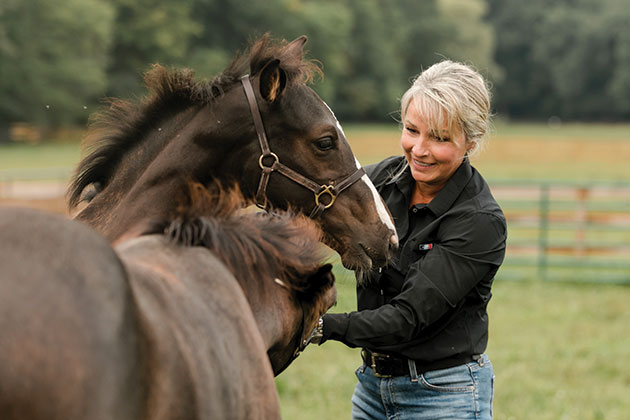
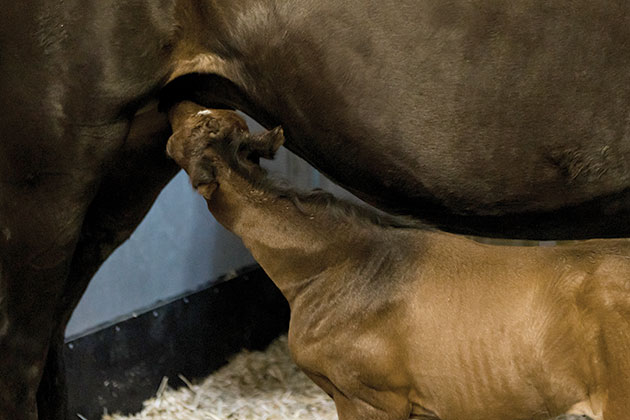
Lactation
After birth, nutrition for the new foal is straightforward. Mare’s milk is tailored for healthy, steady foal growth and provides necessary energy, protein and other essential nutrients. However, the broodmare requires an incredible amount of bodily effort to provide this “liquid gold.” Lactation is the most nutritionally demanding equine life stage as the foal relies entirely on the mare’s milk for about its first month of life, after which it begins to consume other food sources. For the broodmare, feeding adjustments will likely be necessary to provide enough high-quality nutrition to support her energy and protein requirements. Interestingly, even if provided insufficient nourishment, the mare’s milk production does not decline. The mare’s body will mobilize its own tissue stores to attempt to make up for nutritional shortcomings. However, milkfat content decreases significantly in underweight mares, and dietary vitamin and mineral deficiencies have a direct effect on milk composition.
Nutrient requirements of the lactating broodmare significantly increase to facilitate milk production. Energy requirements almost double. A mare in early lactation (about the first 2 months after birth) is capable of producing 3-4% of her body weight in milk — that is up to 44 pounds of milk per day for an 1,100-pound mare. Because milk is predominately water, providing plenty of fresh, clean drinking water during lactation is a must. The mare’s water consumption may increase up to 24 gallons a day.
The mare in early lactation will likely require 2.5-3% of her body weight in total feed daily. For an average mare, this is between 27.5-33 pounds of feed each day. Provide consistent access to good grass hay. If not included earlier, consider adding alfalfa to the lactating mare’s diet. This higher-energy hay is also an excellent source of amino acids with great levels of calcium — all things a lactating mare needs at higher levels while producing milk. Lactating broodmares may need concentrated feed to maintain their body condition. If introducing a concentrate for the first time or if the mare went off feed at the end of gestation, introduce a small amount gradually, over seven to 10 days, building up to the target amount to avoid digestive disturbances. Use a flaxseed oil to bring fat into the diet. Fats and oils provide over twice the calories that an equivalent amount of carbohydrates or proteins do. This can be helpful for hard-keeping mares and those that lose significant weight during lactation. The mare’s body condition is the best way to easily know if she is consuming enough calories.
After three to four months, milk production will begin to gradually taper off as the foal decreases nursing time and continues to graze and take interest in other feeds. Once the foal is weaned, usually between four and seven months, the mare’s nutrient requirements will then return to maintenance or pre-pregnancy.
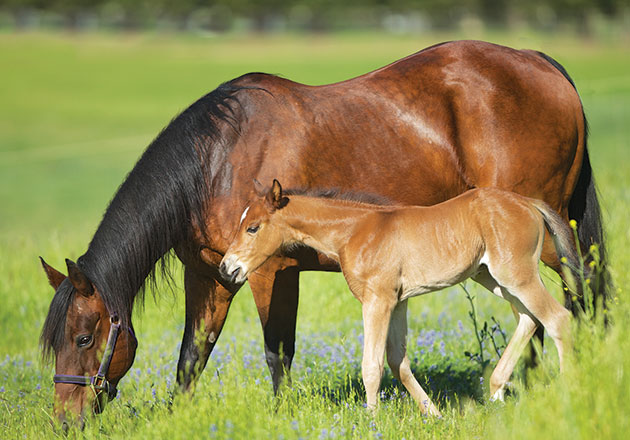
Favorable Factors for a Recip Mare Include:
- Approximate size or slightly larger than donor mare
- Passes a veterinary breeding soundness exam
- No vices (can influence foal’s learned behavior)
- Fertile and free of reproductive problems
- A history of delivering live, healthy foals
- Normal estrous cycles
- Handled and easy to catch
- Healthy body condition
- No significant lameness
- 3 to 15 years old is ideal
- Good temperament
Platinum Protocols
For best results, start supplementing 30-60 days prior to breeding season. Recommendations are based on an 1,100-pound adult horse.
| Recipient Mare Wellness | |
| Platinum Performance® GI: 2 scoops daily |
A comprehensive blend of omega-3 fatty acids, amino acids, macro and trace minerals, vitamins and antioxidants that helps maintain normal inflammatory pathways. Studies have shown that providing a mare with a source of omega-3 essential fatty acids and antioxidants can positively influence ovulation and fertilization. Pre- and probiotics and glutamine support digestive health and promote intestinal microflora that aid in the absorption of nutrients. |
| Healthy Weight oil: 2 ounces daily |
A comprehensive blend of omega-3 fatty acids, amino acids, macro and trace minerals, vitamins and antioxidants that helps maintain normal inflammatory pathways. Studies have shown that providing a mare with a source of omega-3 essential fatty acids and antioxidants can positively influence ovulation and fertilization. Pre- and probiotics and glutamine support digestive health and promote intestinal microflora that aid in the absorption of nutrients. |
| Recipient Mare, Advanced | |
| PlatinumVET™ Reproductive Care*: 2 scoops daily |
Antioxidants help offset oxidative stress caused by free radicals that may complicate fertilization and implantation in the mare. Omega-3 fatty acids, like ALA (alpha-linolenic acid), support ovulation and mare fertility. Carnitine, required for the utilization of fats for cellular energy production, supports normal blood flow and healthy circulation. |
| Gestation — Embryo Transfer to Month 5 | |
| Platinum Performance® GI: 2 scoops daily |
A comprehensive wellness supplement to support gestation. Human research suggests that omega-3 fatty acid supplementation during pregnancy is positively associated with both gestation duration and birth weights. Mares supplemented with omega-3 fats may alter a foal’s predisposition to various health conditions. Glutamine, preand probiotics support digestive health and promote intestinal microflora that support feed efficiency. |
| Gestation — Month 6 to Foaling | |
| Platinum Performance® GI: 2-4 scoops daily |
Trace minerals and vitamins are vital for mare health and the development of the rapidly growing fetus. Omega-3 essential fatty acids, antioxidants and other key micronutrients provide a positive effect on growth, development and the overall health of the foal. Pre- and probiotics and glutamine support digestive health and a healthy population of good bacteria to support feed efficiency and support a healthy immune system. |
| Vitamin E: 1-2 scoops daily |
Adequate vitamin E levels are necessary for neurological development of the foal. Foals born to mares supplemented during pregnancy with vitamin E may also benefit from a stronger immune system as noted by higher levels of serum antibodies when compared to non-supplemented mares. Supplementation is likely necessary if the mare does not have access to fresh pasture. |
| Osteon®: 2 scoops daily |
Supplementing the mare with a bioavailable source of silicon supports neonatal development, growth and maturation of bones and other connective tissues. Supplementation is especially important if the mare has a history of offspring with orthopedic issues. |
| Lactation | |
| Platinum Performance® GI: 2-4 scoops daily |
Omega-3 essential fatty acids, antioxidants and micronutrients offer extra support during lactation — the mare’s most nutritionally taxing stage of life. For the foal via mare’s milk, vitamins, minerals and omega-3 fats are needed for normal bone mineral content, density, strength and growth. Pre- and probiotics and glutamine support digestive health and promote intestinal microflora that aid in the absorption of nutrients. |
| Healthy Weight oil: 2-4 ounces daily |
Rich in omega-3 fatty acids, flax oil infused with natural vitamin E provides healthy fat calories without excess starch and concentrate intake. |
| Vitamin E: 2 scoops daily |
Natural vitamin E protects cell membranes against oxidative stress and supports healthy nerve function. Newborn foals are very susceptible to vitamin E deficiency and are highly dependent on the vitamin E content in the mare’s colostrum. Supplementation is likely necessary if the mare lacks access to fresh pasture. |
| Osteon®: 2 scoops daily |
Foals that nurse from mares supplemented with a bioavailable source of silicon have demonstrated a significant increase in their serum silicon. Supplementation with silicon promotes an increase in bone mineral content and formation in foals. |
*Talk to your veterinarian or call a Platinum Advisor to see if PlatinumVET™ Reproductive Care is right for your mare.
A Closer Look
Omega-3 Fatty Acids & Reproductive Success
Research studies confirm that omega-3 fatty acids improve fertility, colostrum quality and passive transfer of antibodies between the recipient mare and foal.
A horse’s intake of vital nutrients, including omega-3 fatty acids, amino acids, antioxidants, vitamins and trace minerals has been shown to play a significant role in cellular health for improved outcomes, including reproductive success.
E. Carnevale et al, CSU Research 2016.
STUDY: A group of sub-fertile mares ranging in age from 6-25 years were fed a hay-based ration and a commercial grain-based feed (control diet) then were changed to a ration of hay and a comprehensive wellness formula for 8-16 weeks.
OUTCOME: Eggs were harvested when the mares were on the control diet and the supplemented diet and embryos were implanted in to recipient mares. Pregnancy rates on the supplemented diet improved from 23 to 51 percent, a 129% increase.

